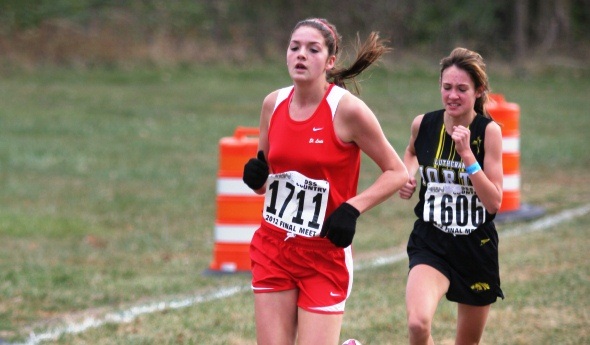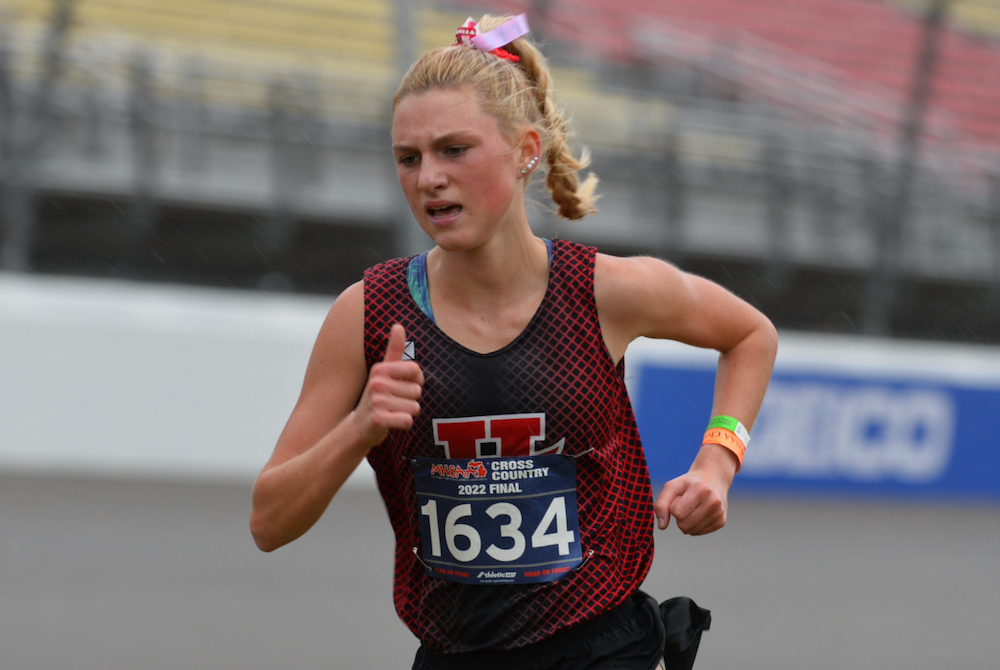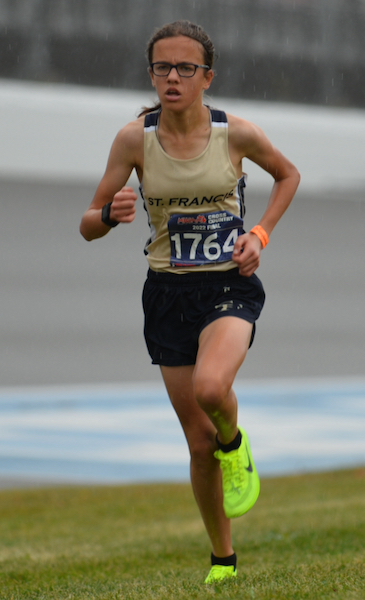
Patterson Makes Move From 6th to 1st
November 3, 2012
By Bill Khan
Special to Second Half
BROOKLYN — Gina Patterson of Macomb Lutheran North was one of the favorites to win the MHSAA Lower Peninsula Division 3 cross country championship, based on her performance last season.
She may have been the only person who didn’t view herself as one of the runners to beat.
Perhaps it was the power of tempered expectations that relieved her of any pressure. Whatever it was, Patterson dominated a field that featured some of last year’s top finishers to win going away with a time of 17:43.4 Saturday at Michigan International Speedway.
Patterson was sixth at the MHSAA Final last season, finishing behind three runners who were in Saturday’s race.
St. Louis senior Raquel Serna was the runner-up for the second straight year, finishing in 17:59.8. Shepherd junior Kaylie Rhynard, who was fifth last year, took seventh in 18:25.9. Ida sophomore Ashley Sorge, fourth last year, was eighth in 18:33.6.
“I just came out here and looked forward to having a good experience,” Patterson said. “It was a great surprise.”
In shattering her personal best, Patterson reached the mile in just under 5:30. She took the lead for good after the two-mile mark.
“It felt great,” she said. “I didn’t know how fast we were going. When we crossed the line, I wasn’t expecting it to be that quick of a first mile. I just pushed it to finish it and seal it.”
As the race unfolded, she wasn’t sure if the fast early pace would catch up with her.
“I kept looking back and thinking if I was going too fast and what was going to happen,” said Patterson, who was relieved to see the gap between her and Serna growing as she entered the stadium for the final half mile.
The team race was considerably closer, with Jackson Lumen Christi edging Grandville Calvin Christian by a 167-171 margin. Caro was third with 201 points.
It was the Titans’ ninth MHSAA team championship and first since 2007.
Sophomore Caitlin Clark was 18th among team runners in 19:09.1, followed closely by sophomore Aubrey Penn in 19th place in 19:10.8 to lead Lumen Christi. Rounding out the scoring were freshman Jensen McEldowney (35th, 19:46.4), senior Leanne Leuthard (40th, 19:54.7) and senior Anna Berkemeier (55th, 20:16.5).
PHOTO: St. Louis' Raquel Serna (1711) and Macomb Lutheran North's Gina Patterson keep pace at the front of the Division 3 Final. Patterson broke away for the win. (Click to see more from RunMichigan.com.)

Jazwinski Brings Hart Individual Title as St. Francis Moves to Front of Team Pack
November 5, 2022
BROOKLYN – Cross country races can be won between the ears before runners ever step foot onto the course.
Attitudes were tested as rain began to descend on Michigan International Speedway and the wind picked up just before the start of the MHSAA Lower Peninsula Division 3 girls race late Saturday morning.
Hart sophomore Jessica Jazwinski was loving life as she prepared to race.
“As a distance runner, I really try to love the wind,” she said. “Distance running and cross country is just a tough sport. The wind just adds to it — and the rain, too. It’s super fun.
“I was just thinking these conditions are just gonna feed my great race. This is real cross country. Yeah!”
Jazwinski overcame the elements to run the fifth-fastest Division 3 time ever, winning with a time of 17:36.70. She has two of the top-five times in Division 3 Finals history, having run 17:31.4 to place third last year.
“Today my race plan was just to go out hard and try to hold on to my pace,” she said. “I feel like I tried to race a lot like Steve Prefontaine, just go out and hold on.”
 Lansing Catholic senior Hannah Pricco was second in 18:17.59, Onsted sophomore Emmry Ross was third in 18:20.96 and Hart junior Alyson Ens was fourth in 18:28.52.
Lansing Catholic senior Hannah Pricco was second in 18:17.59, Onsted sophomore Emmry Ross was third in 18:20.96 and Hart junior Alyson Ens was fourth in 18:28.52.
“I love having great teammates to work with and encourage each other,” Jazwinski said. “We really try to encourage each other so much throughout the races. Throughout this year, some races she’s been a minute behind me, some races she’s been five seconds. I don’t want her to ever beat me, so that pushes me so much. I know she’s trying to race me and get up there with me.”
The only downer for Hart was having its string of Division 3 championships end at five with a fourth-place finish. Hart had two runners in the top four, but its No. 3 runner was 68th.
“I would totally trade my individual title for a team title,” Jazwinski said.
Traverse City St. Francis emerged from a close battle to win its first title since 2016 with 134 points. Pewamo-Westphalia was second with 142 and Lansing Catholic third with 165.
Sophomore Betsy Skendzel led St. Francis, placing seventh in 18:48.33. Completing the team score were senior Sophia Rhein in 26th (19:43.27), sophomore Grace Slocum in 33rd (20:07.95), junior Rylee Duffing in 60th (20:44.82) and junior Margot Hagerty in 63rd (20:45.78).
Lansing Catholic had three place in the top 10, but didn’t get another finisher until 103rd.
PHOTOS (Top) Hart’s Jessica Jazwinski pushes toward the finish during Saturday’s LPD3 Final. (Middle) Traverse City St. Francis’ Betsy Skendzel leads the way for the eventual team champion. (Click for more from Dave McCauley/RunMichigan.com.)

